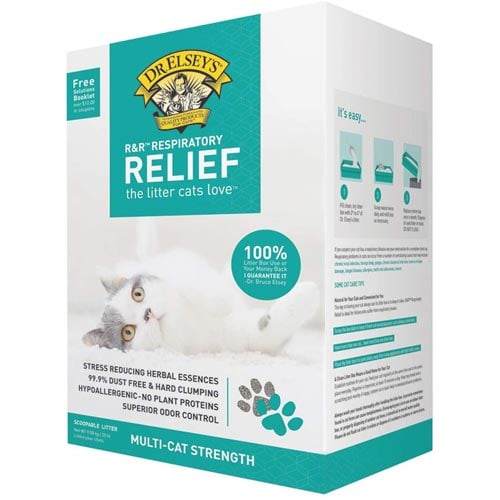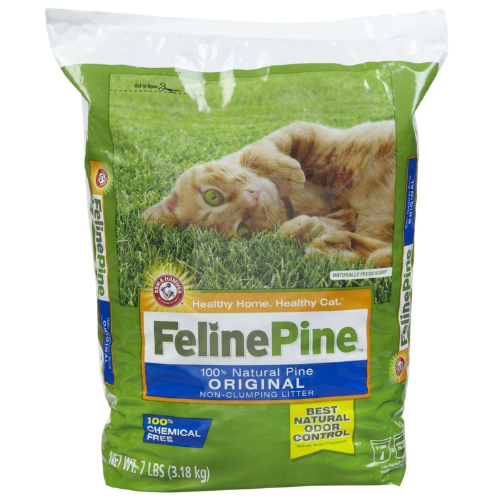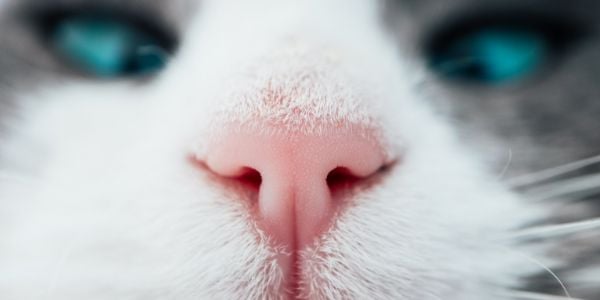 Often in life, experience is the best teacher.
Often in life, experience is the best teacher.
To understand what your cat may be experiencing when they have asthma, it may be helpful to "walk a mile in their paws."
So, to give you insight into what an asthma attack may feel like to your cat, I want you to try an activity.
For this activity, you will need a plastic straw and, if available, a coffee stirrer.
Skip to:
- Run in place for 30 seconds, then stop and assess how you feel – focus on how you're breathing.
- Get your straw. Run in place for 30 seconds while holding your nose and breathing through the straw. Stop and assess how it feels breathing through the straw.
- Get your coffee stirrer. Run in place for 30 seconds while holding your nose and breathing through the stirrer. Stop and assess how it feels breathing through the stirrer.
The part where you breathe through the straws is similar to what it feels like to have an asthma attack. For your cat, it feels impossible to get oxygen into their lungs. The big difference is that they don't understand why, so it's even more stressful for them.
To truly help your cat, it is important to understand what asthma is, how to recognize the symptoms, and what you can do to help protect your cat from having frequent and severe attacks.
What Is Asthma and What Causes It in Cats?
To put it simply, asthma (more appropriately called feline allergic bronchitis, or FAB) is a respiratory condition of the lower airways of the lungs caused by an allergic reaction, other forms of hypersensitivity, and even stress. But unfortunately, it is more complicated than it sounds.
To help you understand asthma more specifically, you need to know the definition of a couple of words:
Antigen: A foreign substance or toxin that the immune system perceives as a threat.
Allergens: This is an antigen the immune system fights off since it is a perceived threat.
Antibodies: A protein the immune system produces to neutralize foreign invaders (antigens).
Your cat's body has developed specific antibodies to target allergens they inhale. When there has been repeated exposure to the allergen(s), a cascade of events begins when the antibodies recognize the allergen(s).
- Several different types of immune cells are brought to the airway.
- The immune cells spark the production of substances that cause inflammation.
- The inflammation causes the airways to become irritated, swell, and constrict.
- The airways become narrowed and accumulate mucus.
- Air movement is then limited through the airways making breathing difficult.
- The end result is an asthma attack.
Between 1–5% of cats are affected by asthma, with the average age of diagnosis between 4 and 5 years. Gender and breed do not appear to affect susceptibility. However, there are some studies that indicate, but nothing has been proven, that Siamese Himalayan cats may be predisposed to asthma.

What Are the Symptoms of Asthma and an Asthma Attack?
It is important to recognize when your cat has asthma, especially if they are experiencing an asthma attack. Because cats panic and become stressed when they can't breathe, the symptoms can progress quickly.
To make it easier to breathe, your cat may crouch down low with a hunched back. They can also extend their neck and cough or wheeze. If you’ve seen your cat trying to get out a hairball, you’ve likely seen this posture.
During a full-fledged attack, your cat's sides may move in and out quickly as they attempt to breathe. They may drool or cough up mucus as well.
A cat’s normal breathing rate is 24 to 30 breaths per minute (bpm) when resting. If your cat is having trouble breathing or is taking more than 40 breaths per minute (while resting or sleeping), it’s time to call your veterinarian or go to a veterinary emergency hospital immediately. If no action is taken, the situation can progress rapidly and become fatal.
Common symptoms of asthma that you may notice:
The symptoms of cat asthma can range from mild to severe. They can occur spontaneously or if the throat area has light pressure applied. Symptoms worsen as they approach or are having a full-blown attack.
- Noisy breathing when asleep. Not all cats that snore or breathe noisily when sleeping have asthma. But if you are concerned, contact your veterinarian.
- Coughing persistently and may be initially non-productive but can possibly have some foamy mucus
- Gagging
- Swallowing a lot
- Wheezing, rattling, or cracking sounds are noticeable when breathing
- Vomiting
- Struggling or having difficulty breathing
- Very quick breathing (more than 30 bpm)
- Gurgling in the throat
- Weakness and lack of energy
- Lips and gums turning bluish
- Flared nostrils when breathing
- Open-mouth breathing (resembles panting, but worse – mouth is wide open, and tongue is stiffer)
Questions? To chat with a veterinarian about the possibility that your cat has asthma, Click here
These two videos show early, mild symptoms. But if treatment isn't provided, these attacks can become bad. The second video below shows how the neck becomes extended during an asthma attack.
What Triggers Asthma in Cats?
Certain triggers can cause your cat to suffer an asthma attack. Awareness of and avoiding your cat's particular trigger(s) helps decrease the number of episodes they may have.
Potential environmental triggers include:
- Dust and dust mites
- Pollen
- Grass and weeds
- Flowering plants
- Mold and mildew
Potential household triggers include:
- Smoke (cigarettes, fireplace, candles)
- Cleaning products (especially aerosols and scented cleaners)
- Carpet powders
- Aerosol sprays of any kind
- Air fresheners
- Perfumes
- Fabric softeners (used on bedding or anywhere your cat lounges)
- Cat litter dust (see our list of better litter options below)
- Some flea sprays or powders
- Scented pet shampoos
- Pet colognes
- Paint
- Flowers
Even some foods can trigger allergies or asthma in cats. Some of the most common food triggers are fish, beef, soy, and corn.
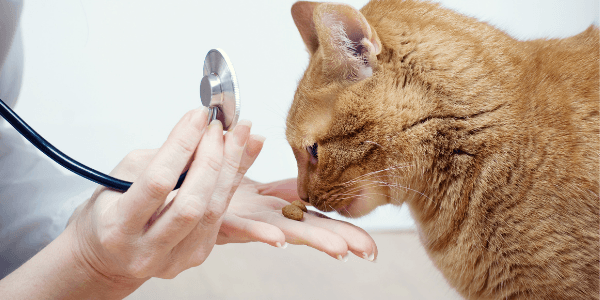
How Is Cat Asthma and FAB Diagnosed?
To diagnose feline asthma, you first have to eliminate other possibilities. That’s because there’s no test that can give you a positive or negative result for asthma. Your veterinarian will look for conditions like heart disease, infectious pneumonia (bacterial, fungal, or parasitic), lungworms, feline heartworm disease, and cancer (either primary or metastatic).
Because the list of "other potential causes" is extensive, multiple diagnostic tests are necessary, in addition to a complete physical exam. The tests are used to evaluate your cat's general health as well as provide a possible indication of the underlying cause.
Some of the tests your veterinarian may perform include:
- Complete blood count (CBC): This test identifies elevations in certain cell types that can indicate infection, allergies, or that your cat has parasites.
- Blood chemistries: Evaluates general organ function and blood protein levels.
- Heartworm test: Evaluates for the presence of heartworms, which is a condition that targets the lungs.
- Fecal exams: Poop samples identify if any parasites, such as lungworms, are present.
- Urinalysis: Identifies urinary tract infections (UTI), kidney problems, and other medical conditions.
- Blood pressure check: Evaluates for high blood pressure (normal systolic pressure is <140 mmHG). If left untreated, can affect and damage the renal, cardiovascular, and nervous systems, which leads to similar symptoms of asthma.
- Chest radiographs: X-rays show changes in the lungs, heart, and vessels.
- Echocardiogram: Evaluates the heart.
- Bronchoscopy: A visual evaluation of the airways via a flexible scope placed down a cat's throat and done under anesthesia.
- Bronchoalveolar lavage: Evaluates mucus from the smaller airways. Done under anesthesia, sterile saline is flushed into the throat, and then samples are taken, looking for microorganisms that can be cultured and white blood cells associated with different medical issues.
Based on the findings during the physical exam and the results of the diagnostic tests, your veterinarian can determine the likely cause of the respiratory symptoms. However, in some cases, a single cause may not be able to be determined. If all other causes are ruled out, your cat will be given the presumptive diagnosis of asthma.
Also, having your cat allergy-tested can help you determine what environmental or seasonal issues may be triggering attacks. Some common ones are dust, pollen, dust mites, and grasses.
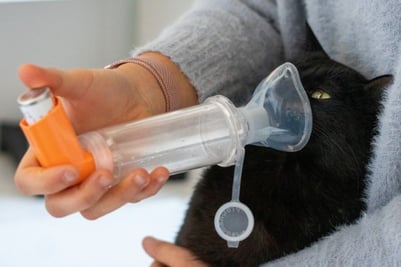 What Is the Treatment for Asthma in Cats?
What Is the Treatment for Asthma in Cats?
While there is no cure for asthma, the good news is that most cats can be treated at home without the need for hospitalization. However, it’s a different story if your cat is in severe respiratory distress. They may need to spend some time in the hospital to get them stable before they can return home.
Depending on the severity of the attack, intravenous medications and oxygen may be given. When they’re feeling better, and it’s safe for them to return home, you’ll be able to continue treatment there.
Your veterinarian may recommend some or all of the following in an effort to minimize the number of attacks and keep them mild:
-
Avoidance of triggers: Your first line of defense is eliminating as many things that can trigger an asthma attack. See the list of possible triggers above.
-
Bronchodilators: Inhalers used to enlarge or open the airways. Using an aerosol chamber made for cats, like the one in the photo, helps administer the exact dose. It's truly a life saver. Watch this video to learn how to use it and ensure your cat is inhaling enough times to get the full dose.
- Corticosteroids: Inflammation in the lungs can be decreased by giving medication in pill form.
- Hypoallergenic diet: Ingredients in food can contribute to attacks. So, prescription diets can eliminate these possible triggers.
- Immunotherapy: Like in people who suffer from allergies, it’s their immune system that is attacking itself for no good reason. It perceives a threat, like pollen, and causes the body to fight it. So, working on strengthening the immune system by introducing the allergen gradually over time can be helpful.
Immunotherapy can be given by oral drops under the tongue or shots. Either can be done at home or at the vet's office. It can take between 18 and 24 months to determine if it is working and providing full relief. However, you may see some relief at 3 to 6 months. It generally has a success rate of 85%–90% in improving symptoms. - Omega 3 fatty acids: Supplements like fish oil are a natural anti-inflammatory way to support overall health, including reducing inflammation in the lungs. These are a few of our favorite, high-quality brands: Omega Benefits, Nutramax Welactin, and Nordic Naturals.
- Veterinary acupuncture: It will depend on how bad your cat is, but a session is about 2 to 30 minutes long, and a minimum of 3 to 10 sessions is needed 1 to 2 weeks apart. Acupuncture can help boost the immune system and reduce inflammation. It can also help reduce the intensity of muscle spasms.
- Chiropractic adjustments: During an asthma attack, the chest tightens, affecting the nervous system and the thoracic nerves. Chiropractic adjustments can help increase chest expansion and flexibility. It also helps your cat with their emotional well-being and stress, as stress is a trigger for asthma.
Tips to Reduce Asthma Attacks
Even though there is no “cure” for asthma, cats can lead normal and active lives with proper management and supportive treatment.
Keep Track
Carefully monitoring and documenting the details (time, date, severity, and treatment) when your cat has an attack helps you determine what potential triggers are so that you can take steps to avoid them in the future. And it helps keep track of their progress.
Get Your Cat Allergy Tested and Manage the Triggers
An allergy test can help identify what environmental or seasonal triggers are causing your cat's asthma attacks. To help with managing environmental triggers, in addition to possible immunotherapy (allergy shots), you can implement one or more of the following:
- Keep windows shut when you can to reduce environmental allergens inside your home.
- Keep your cat indoors.
- Vacuum and dust daily to decrease dust and dust mites.
- Use dust mite covers wherever possible (pillows, beds, pet beds, etc.).
- Don't use air or carpets fresheners (aerosols or plug-ins).
- Avoid all types of smoke (cigarettes, candles, incense, fireplaces, etc.) around your cat.
- Use air purifiers with HEPA filters. PureZone and Koios are two good options.
- Use filters on air conditioning units that trap airborne allergens.
Reduce Stress for Your Cat
As mentioned, stress can aggravate your cat's asthma. Taking steps to help your cat remain calm as much as possible is important in managing asthma. The following are a few options:
- Getting enough enrichment is an important stress reducer. Food puzzles or toys are vital.
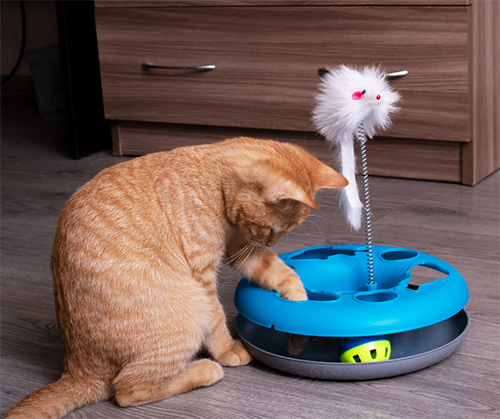
- Interactive play with a wand toy simulates predator/prey interaction and greatly reduces stress. Our article about different types of cat toys explains how to complete their natural prey sequence to satisfy your kitty.
- Try calming treats. We like these treats: VetriScience Composure Treats, NutraMax Solliquin Behavioral Supplements, or Vetoquinol Zylkene. You can try putting up to 4 drops of Rescue Remedy on their regular cat treats or food, as needed. Because Rescue Remedy is plant-based, be careful to monitor your cat after giving it or if allergy testing came back with any items on the ingredient list that they are allergic to.
- Probiotics like Purina Pro Plan Veterinary Supplements Calming Care Feline Formula can help. Good gut health is important for immune system health.
- Plug in Feliway pheromone diffusers throughout your home.
NOTE: There are some people who think that this type of diffuser aggravated their cat's asthma. We spoke with a veterinarian at CEVA, the manufacturer, who assured us that those reported cases had other triggers causing the attack, and they felt very comfortable recommending it for cats with asthma. But just to be safe, monitor your cat closely when first using. Pheromones have great calming effects, so it could be worth a try for your cat. - There are prescription calming diets your veterinarian can recommend as long as your cat doesn't have food allergies.
- Provide a hide-away place where your cat can feel safe. Space and perches up high and off the ground are also important. If you have a lot of boxes, we have just the cat condo you can make!
- If your cat isn’t getting along with your other pets, Try working on those relationships. They can be big stressors.
- Keep the general environment of your household calm.
Weight, Arthritis, and Cat Asthma
Another reason to keep your cat active, besides to help lessen stress, is to help control their weight. The severity of asthma can be worse if your cat is overweight. In addition to the excess weight making breathing more difficult and increasing stress on the heart, the chronic inflammation it creates in the body can cause arthritis and weaken your cat's immune system.
If you are unsure of your cat's ideal body weight or how to help them lose weight, speak with their veterinarian. We have some tips on helping your cat lose weight and how much to feed your cat.
Chronic discomfort or pain from arthritis can be a significant source of stress for your cat, too. A weakened immune system makes them more susceptible to infections which can trigger asthma attacks.
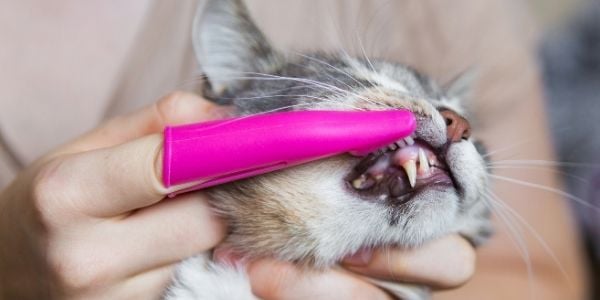
Preventing dental disease is important for all cats but especially those with asthma. Dental disease increases the chance of serious secondary bacterial infections when the bacteria move from the mouth into the lungs. Be sure your cat gets routine oral exams by their veterinarian and establish an at-home dental care routine that includes brushing their teeth, dental chews, oral rinses, etc.
Cat Litter and Asthma
There are dust-free and low-dust litter options that are better for cats (and people) with asthma.
Litter can affect your cat because the dust from typical clay and other dusty litters can lead to irritation of the airway, triggering an asthma attack. Below are several litters that have been known to work best for most cats with asthma.
If you, your cat, or someone else in your household has asthma or FAB, I'd suggest discussing these litters with your veterinarian and seeing if they might be right for your situation.

Cat Urine Can Affect Your Cat's Asthma
Ammonia is a potent respiratory irritant that is in all cat urine. It can be an irritant to cats and their people. So, for this reason, for cats with FAB or those suffering from any respiratory issues, it’s always best to go with an uncovered litter box, as the covered varieties can trap the ammonia inside.



